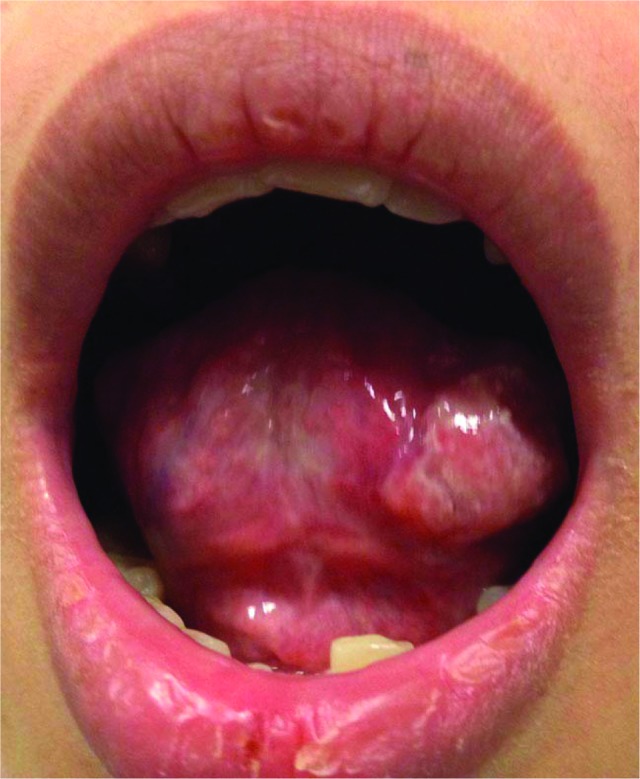Abstract
An instance of squamous cell carcinoma resulting from long-term treatment with pegylated liposomal doxorubicin in a woman with no risk factors for this malignancy is reported.
Keywords: Pegylated liposomal doxorubicin, Giant cell tumor, Secondary malignancy, Squamous cell carcinoma
To the Editor,
Cannon et al. [1] recently reported on five women with recurrent ovarian and fallopian tubal cancer who developed oropharyngeal squamous cell carcinomas (SCCs) during long-term maintenance therapy with pegylated liposomal doxorubicin (PLD) (range, 30–132 months; cumulative dose, 1,696–3,000 mg/m2). We now describe its possible role in the development of SCC of the tongue in a young woman with a giant cell tumor of the bone metastatic to the lung. A noteworthy feature of this occurrence was the rapid growth of the tongue tumor shortly after diagnosis.
Briefly, a 28-year-old female Chinese patient without a family history of cancer or history of tobacco or alcohol use was diagnosed with a giant cell tumor of the left distal femur and was initially treated with local excision in June 2004. She underwent a more extensive local excision coupled with curettage, phenol, and cement on the tumor bed in November 2004, but this procedure was also followed by local recurrence. Preoperative assessment prior to a more radical excision in October 2005 revealed multiple bilateral lung metastases, and needle biopsy of a left lower lobe nodule confirmed a metastatic giant cell tumor. In June 2006, she finally underwent radical resection of the left distal femur for local recurrence with placement of a distal prosthesis, and PLD was initiated to control her lung metastases. Between September 2006 and August 2008, she received 40 mg/m2 PLD every 3 weeks for 18 cycles (cumulative dose, 1,080 mg) with documented marked improvement in her nodules on a chest computed tomography (CT) scan 4 months after her last dose. PLD was resumed in December 2009 when regrowth was noted; her left ventricular ejection fraction continued to be normal, but this treatment was stopped after three cycles as a result of 20% progression in four lesions (PLD final cumulative dose, 1,260 mg). Zoledronic acid was given monthly from April 2010 to October 2010, followed by denosumab monthly since November 2010, until prior to her recent surgery. In March 2011, a chest CT scan already showed a significant interval response to this therapy. There was further improvement by July 2011 that persists to date along with the total absence of any respiratory symptoms (some dyspnea on exertion had been present during the last PLD treatments). She works as a waitress, has never smoked, is only a social drinker, and describes no illicit drug use. She married in early 2011 and her husband is her only sexual partner. During her monthly visit in August 2012, she complained of a lesion on the left lateral side of her tongue (Fig. 1). Because of our awareness of similar complications in women with ovarian cancer, we obtained a biopsy on the same day, which showed SCC. While planning definitive resection, rapid growth was noted when she underwent partial glossectomy and left supraomohyoid neck dissection on September 5, 2012. Pathology revealed SCC, moderated differentiated, all margins negative, no perinural or angiolymphatic invasion, neck dissection 0/12, and stage T1N0M0 (tumor size, 1.6 cm). The tumor was frozen for possible additional characterization.
Figure 1.

Left tongue squamous cell carcinoma.
In summary, we report an aggressive SCC of the oral tongue in a woman after a 2-year exposure to PLD for a metastatic giant cell tumor of the bone. This relatively uncommon tumor of the bone in adolescents and young adults may display malignant behavior and metastasize to the lungs in <5% of instances. To our knowledge, this tumor is not associated with the appearance of secondary tumors, and other etiologies for her SCC are not readily apparent in this instance. Also, we know of no association between secondary malignancies or SCCs of head and neck origin and bisphosphonate or rank-ligand inhibitor treatments. Therefore, we conclude—as recognized by the first author immediately upon presentation—that this may be another instance of long-term PLD use and an oropharyngeal SCC in a woman with no risk factors for such malignancies, including any suspected exposure to human papilloma viruses [1, 2].
Editor's Note: We publish in this issue a brief series of related papers and letters that examine possible side effects of long-term exposure to pegylated liposomal doxorubicin (PLD). See pages 1534–1540 for a report of the occurrence of the renal thrombotic microangiopathy in ovarian cancer patients exposed to PLD; pages 1541–1546 for a report of squamous cell carcinoma (SCC) of the mouth in non-smoking women with recurrent ovarian cancer; and pages 1594–1595 and 1598–1599 for two additional Letters to the Editor that relate other cases of SCC of the oral cavity in patients with long-term PLD exposure.
Author Contributions
Conception/Design: Ping Gu, Jennifer Wu
Provision of study material or patients: Ping Gu, Mike Sheu, David Myssiorek, Richard Cohen
Collection and/or assembly of data: Ping Gu
Data analysis and interpretation: Ping Gu, Jennifer Wu
Manuscript writing: Ping Gu, Jennifer Wu
Final approval of manuscript: Ping Gu, Jennifer Wu
References
- 1.Cannon TL, Lai DW, Hirsch D, et al. Squamous cell carcinoma of the oral cavity in nonsmoking women: A new and unusual complication of chemotherapy for recurrent ovarian cancer? The Oncologist. 2012 May 23; doi: 10.1634/theoncologist.2011-0216. [Epub ahead of print] [DOI] [PMC free article] [PubMed] [Google Scholar]
- 2.Ben-David Y, Leiser Y, Kachta O, et al. Does long-term treatment with Doxil predispose patients to oral cancer? Int J Clin Oncol. 2012 Mar 20; doi: 10.1007/s10147-012-0400-1. [Epub ahead of print] [DOI] [PubMed] [Google Scholar]


